A sample text widget
Etiam pulvinar consectetur dolor sed malesuada. Ut convallis
euismod dolor nec pretium. Nunc ut tristique massa.
Nam sodales mi vitae dolor ullamcorper et vulputate enim accumsan.
Morbi orci magna, tincidunt vitae molestie nec, molestie at mi. Nulla nulla lorem,
suscipit in posuere in, interdum non magna.
|
Today was a short day in that we only hiked a little over 2 miles. We headed toward Barafu Camp at 15,200ft where we would depart for the summit the next morning. We were now almost south of Kibo.
Again, we had a sunny morning and clear skies the whole day. The beauty and solitude of the mountain defy description.
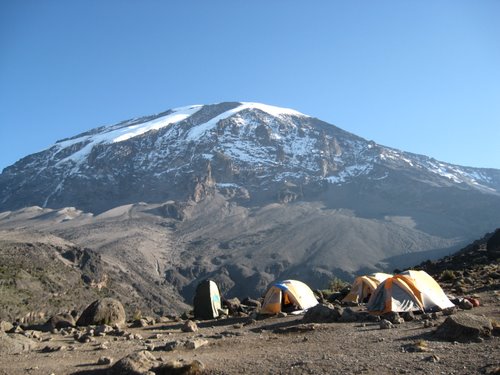
 Hosea's head-balancing skills 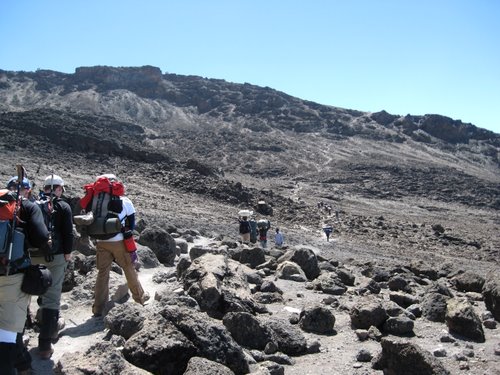
We arrived in camp at 13,222ft to find our tents pitched on a high ledge with awesome views down the slope to the west, and of the mountain to the east.
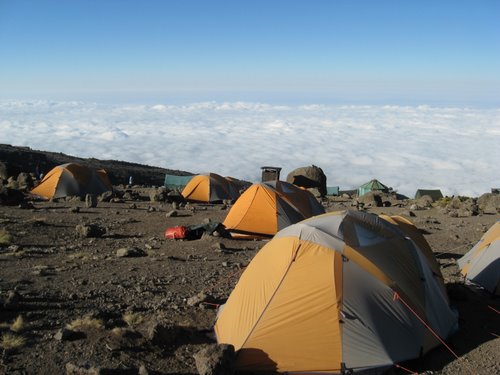 View from Karanga Valley Camp The nights were getting colder, our pulses rates were going up, our oxygen saturation was going down, our appetites were decreasing, and some people were getting bad headaches and feeling nauseous. For the last couple of days at mealtimes, we were all reaching for the ginger tea, made by shredding fresh ginger and steeping it in hot water. The card games were getting shorter too. Amazingly everyone’s tempers were even and everyone was supporting each other in any way they could. People seemed to have good and bad days at different times. I can’t remember an angry word spoken during the entire trip. We were both lucky in the natures of the 8 climbers, and that Wilbert, Faraja, and Hosea were very skilled at high altitude climbing, psychology, and both reassuring and motivating us. They knew what they were doing.
The food all started to taste the same and I had lost my appetite that night. I felt Hosea’s concern. The next morning I still felt bad. He made me eat two bowls of my least favorite food on the whole trip…millet porridge. It was brown and earthy and runny and tasted terrible. He said I might or might not throw up or not, but either way I would feel better. I kept it all down, and amazingly felt much better an hour later.
I woke up after the first great night’s sleep of the trip feeling fantastic. The sun was out again and we set off towards the Barranco Wall, a steep scramble that takes about an hour to climb. This would be a short day, a little over 3 miles, and only a couple hundred feet of net elevation gain.
Along the way starting seeing many more Senecio Kilimanjari, something like a cross between a palm tree and a cactus, that can get 10-15 feet tall. It’s interesting how a plant that big survives up here.
We made it up the wall without incident and were treated to amazing views above the clouds at the top.
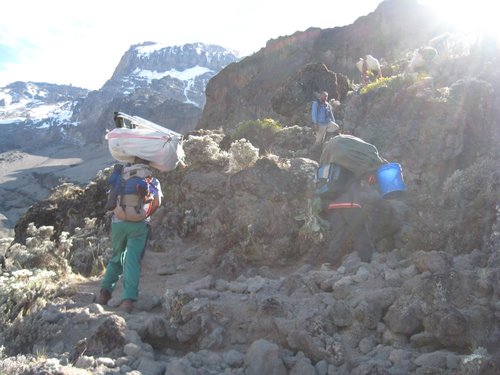
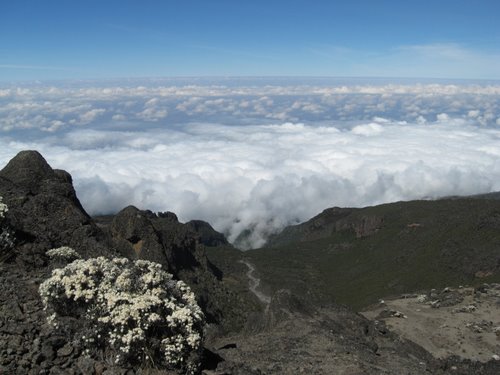 From the top of the Barranco Wall  Jon above the clouds 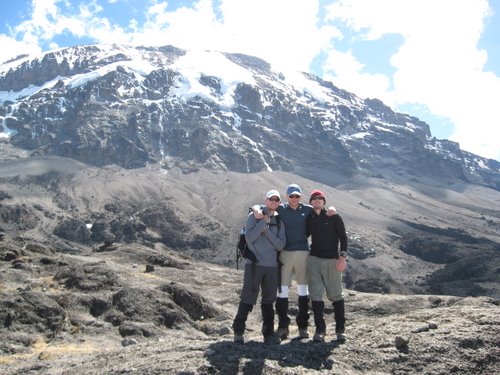 Sean, Tony and Greg 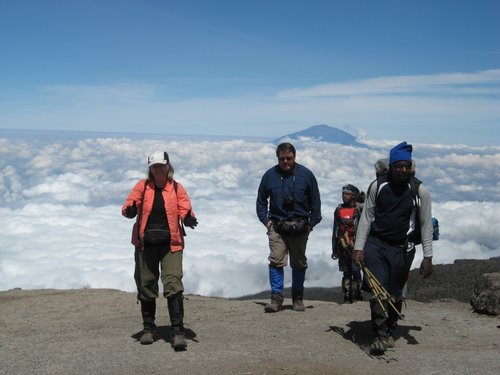 Trish and George, happy to be at the top. Mt. Meru in the distance. We continued through the Barranco Valley after lunch, stopping in the early afternoon to fill our water bottles at the bottom of another steep climb. Thirty minutes later we were in Karanga Valley Camp.
 Barranco Valley 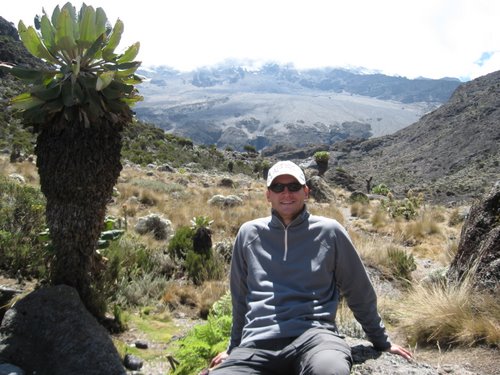 Greg and the Senecio Kilimanjari
Having spent the first three days heading more or less directly at Kibo from the north, this morning we had begun circling counterclockwise around the mountain from the north, and tonight we had made our way to its west. The closer we got to Kibo the larger it seemed.
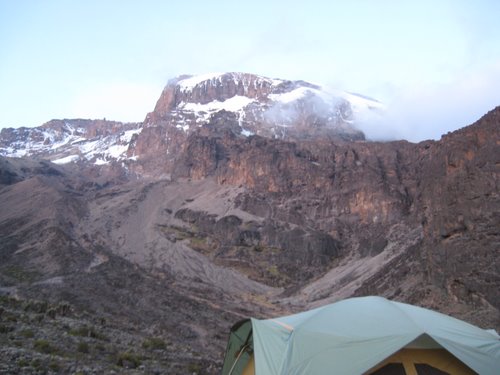
After dinner the sky cleared for some spectacular views from above the clouds down into the valley.
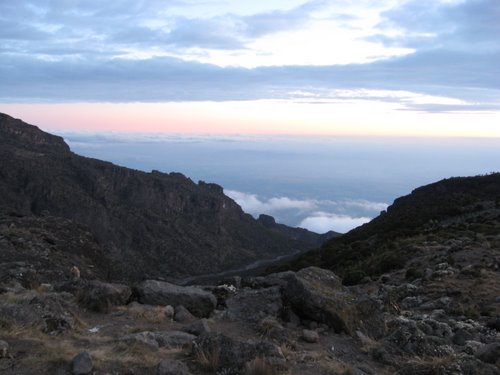
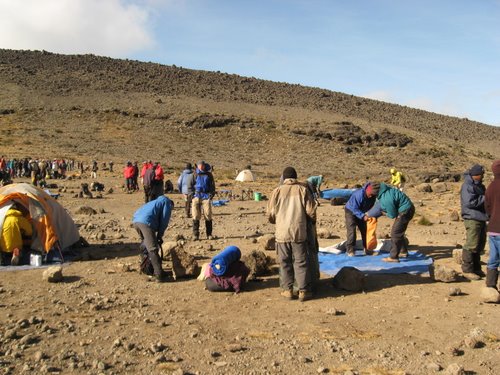
The next morning was sunny again. We set off on a 5.5 mile hike that would take us to 15,300ft at the top of the Lava Tower (optional but highly recommended for acclimitization) and then back down to near 13,000ft for the night. We were going to be near 13,000 feet for several days now for our bodies to adjust to the altitude and make summiting easier.
Even though we had shared a couple of nights at the same camp as the Mountain Madness group, we didn’t see them. They had left before us in the mornings, and we didn’t see anyone else all day. Mid morning on Day 4 the Machame trail joined our route and we saw other people for the first time. But it was just one group. We said hi and soon became separated again and had Africa to ourselves. The scenery was spectacular.
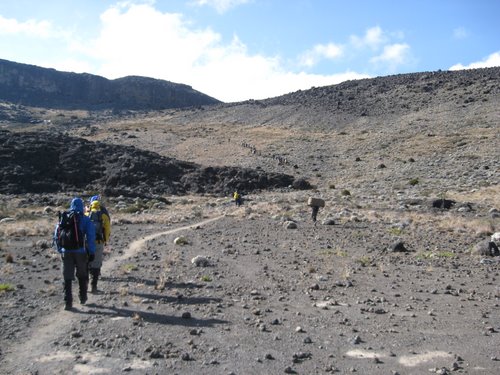
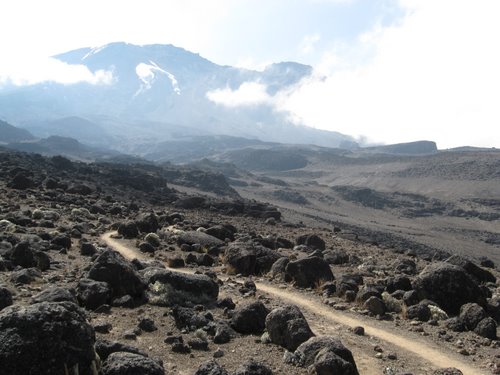
After lunch two of our three groups opted to climb the Lava Tower and we headed toward it. Arriving at the base, Hosea had us take off our packs and leave them at the base. The Tower was basically a 300 foot tall, almost vertical plug of lava sticking up from the surrounding territory. It wasn’t difficult by rock climbing standards but you had to really pay attention in a couple of places. Since it was overcast and foggy we couldn’t really appreciate what it looked like or get a view from the top. Looking on the web at other people’s pictures I can see afterwards what we missed.
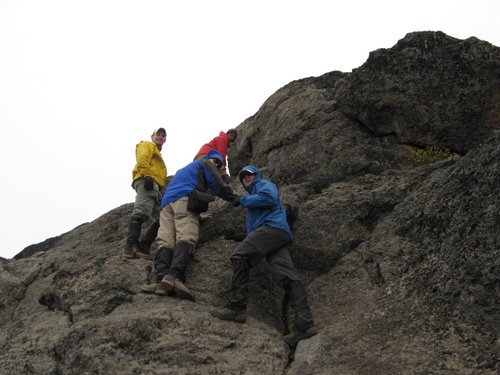 Greg, Tony, Sean and Hosea scrambling up the Lava Tower 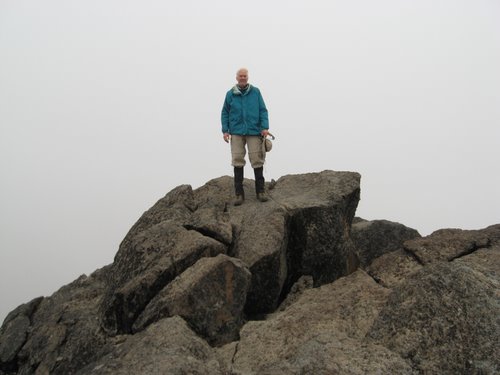 Jon at the top 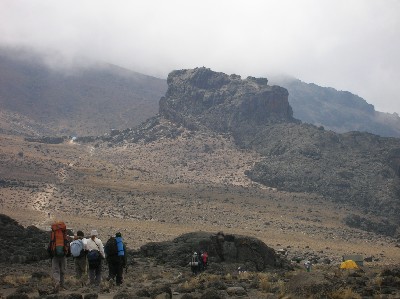 Someone else's picture of the Lava Tower The rest of the day took us back down in elevation through a valley towards Barranco Camp.

The trail brought us to Moir Camp, where there was an old abandoned hut. The temperature continued to drop and we were glad to have our -30degF rated mummy bags. We learned from Wilbert that the less you wear inside these high altitude sleeping bags the warmer you are. It worked. I was much warmer wearing just the thin thermal underwear than I had been the night before wearing polartec tops and bottoms.
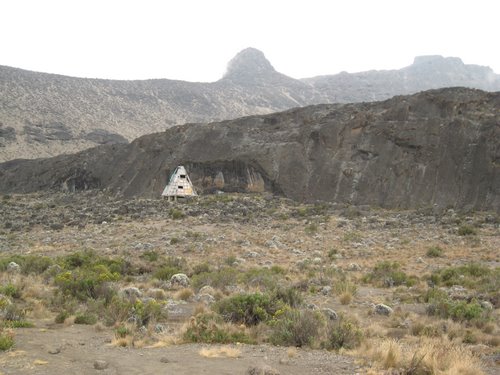
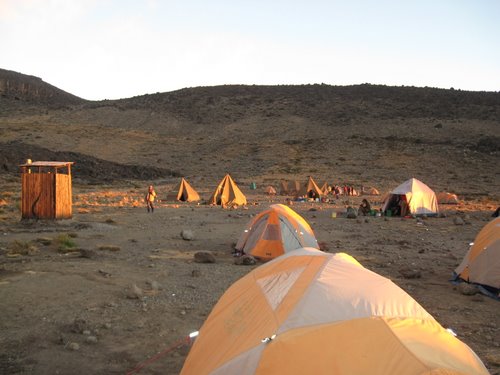 Moir camp I had gotten into a routine. Arrive in camp, have a snack, write in the journal and listen to music, have dinner, play cards, go to bed. I hadn’t slept well the first two nights.
The morning was a complete surprise: sunny and not a cloud in the sky. The hike took us about 7 miles across the Plateau to Moir Camp, at 13,700. The landscape was littered with volcanic rocks from prehistoric eruptions of Kilimanjaro. It turns out the volcano is not extinct, but inactive. The crater at the top still emits hot volcanic gasses.
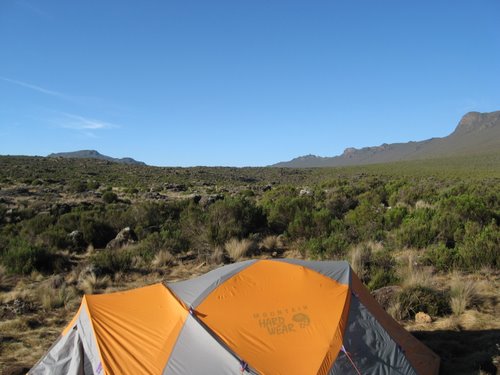
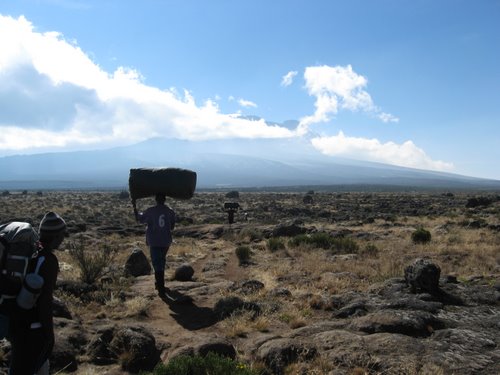
We saw some plants and flowers unique to this area. Some looked almost tropical but they survive in the cold, dry high altitude.
 Lobelia deckenii We walked through an area called Fischer Camp, named after the famed mountaineer Scott Fischer who is said to have pioneered this route up Kilimanjaro. Fischer died on Mt. Everest in the tragic events chronicled in Jon Krakauer’s classic book, Into Thin Air.
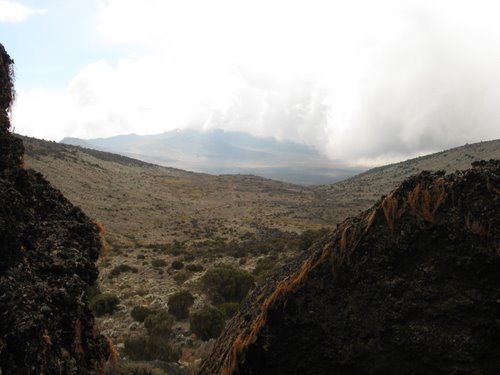
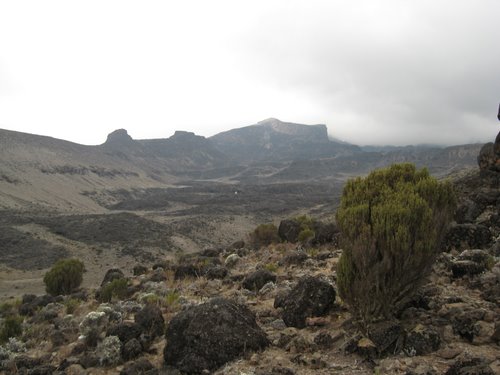
When we walked into Shira 1 camp in the late afternoon Kanini was there to greet me, as he’d be every day, and show me to my tent. Greg had brought a frisbee, so we played that for awhile in the cold, wind and fog, waiting for the others to arrive. It seemed like a good idea at the time.
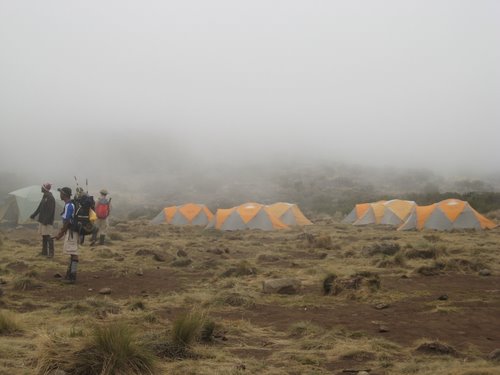

After dinner, we walked out of the tent to be amazed that the clouds had vanished and the sun was shining brightly on Kilimanjaro. It kind of knocked us over. We’d learn that was a typical weather pattern; Clear in the early morning and late evening, and overcast in between. Except when we’d climb near 15,000 ft and get above the clouds.
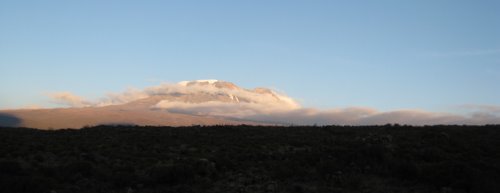
I was awakened in my tent at 6:30 and offered hot coffee, chocolate or tea. I was also given a small basin of warm water to wash with. Yes there were several small luxuries on this trip. I had learned from Peru to get completely organized, packed, and ready to go before breakfast so that you could finish breakfast, brush your teeth, grab your pack, and be ready to go.
In my pack I carried waterproof jackets and pants, a couple of layers of extra clothing, two large Nalgene bottles full of water, a small pharmacy for whatever might transpire during the day, and some odds and ends of things like snacks, passport, wallet, Ipod, and camera. I also carried two tanzanite gems I’d bought in the hotel store. I would carry them to the summit and have them made into earrings for Rachel later.
At the meal tent Wilbert explained we would be walking about 5 miles to the western edge of the Shira Plateau and ending at Shira 1 camp at 11,500 feet. There are five distinct climate/ecological zones on Kilimanjaro: lower montagne forest, upper montagne forest, heath and moorland, alpine desert and summit. We had walked from lower to upper forest on the first day.
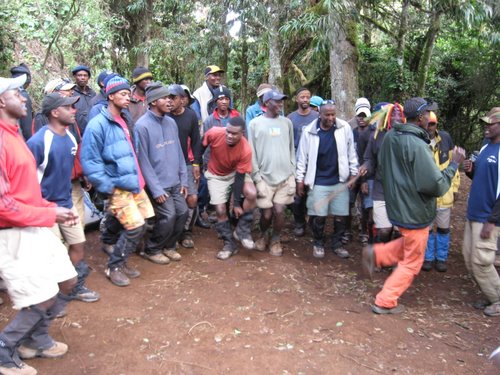
After breakfast we were treated to more dancing and singing. We of course were required to take part. As each of us danced in the center of the circle the Kiliwarriors would shout our name and weave us into the song.
After the fun, Wilbert, Faraja, Trish, George and I set off in a group while the porters set about taking down camp. Greg, Tony and Sean went with Hosea and Stefano and Giuseppe went with the fourth guide.
The day was cool and overcast, with occasional mist and fog. We enjoyed seeing the monkeys, including a spectacular colobus with its long, elegant white tail.
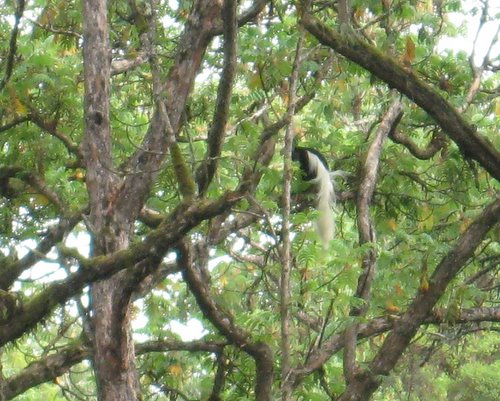 Colobus monkey Mid morning, we suddenly realized we’d left the upper forest zone and were in the heath and moorland zone. It was a surprisingly distinct transition over only a few hundred feet of elevation. The vegetation was completely different with large (over 6 foot tall) heather plants to either side of the trail. We looked back from where we’d come and saw the band of forest below.
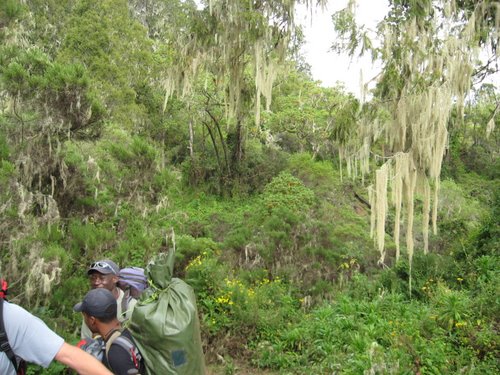
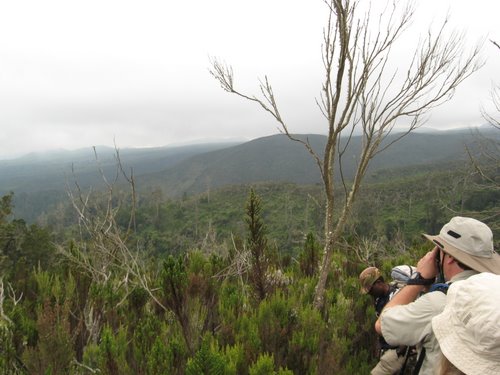
Not much more than an hour after we’d left, the porters passed us on the trail, having cleaned up after breakfast, taken down the camp, and sped on toward the lunch site. This was a twice-daily ritual for us to realize they were fast and we were not. I guess pole pole is not for the locals.
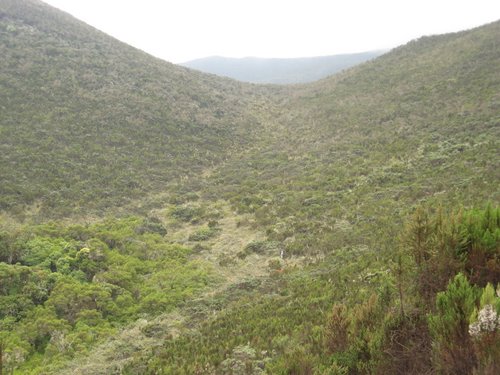
After lunch, I felt like hiking faster and asked Greg, Tony and Sean if they minded if I join them. It was fine with them. Hosea looked skeptical. For the first hour Hosea was with me like a mother hen, asking about every 5 minutes how I felt and if I wanted to rest. He gradually eased up when I showed no signs of collapsing and asked him a couple of times if he wanted to rest. Hosea was quiet, thoughtful, and perceptive and a genuinely great guy from the Chagga tribe, who are generally on the south and east slopes of the mountain and are skilled and educated farmers. We would get to know Hosea well over the course of the trek. We learned, among other things, about how many cows a prospective husband has to pay his intended’s father for the privilege of marrying her. It’s negotiable and depends on how much in demand she is, as one would expect.
 Sean and Hosea 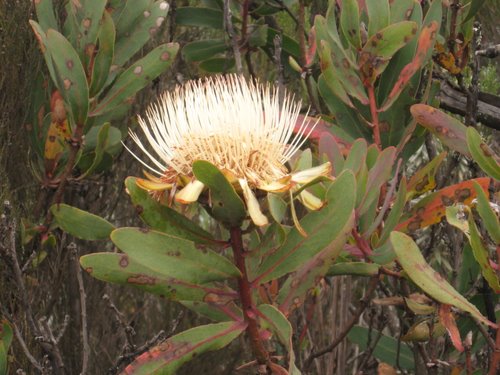 protea kilimandscharica The day alternated high overcast and low mist. Mid-afternoon we reached the edge of the Shira Plateau and the terrain flattened out and provided broad views.
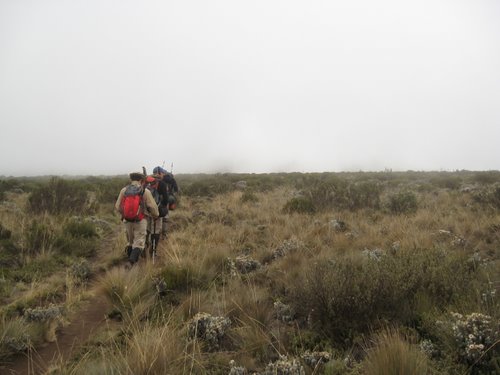 Stefano and Giuseppe march across the plateau
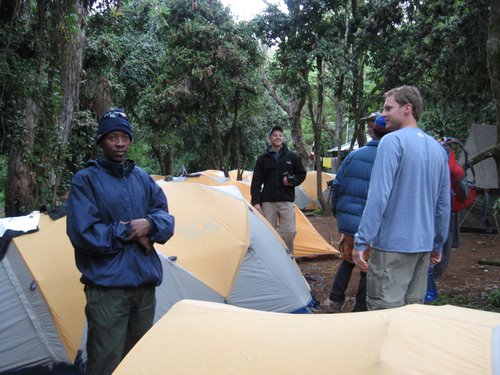 Forest Camp We arrived at the campsite to find our tents set up and the porters welcoming us. I met Kanini, who was to be the man assigned to me for the trek, and he showed me to my tent. He would set up my tent in the evening, take it down in the morning, and carry my duffel bag during the day. Kanini had a huge smile and a great personality. He would always come out to meet me at the end of each day to welcome me into camp and congratulate me.
 Dining Tent After we’d put our packs in our tents we went to the dining tent where there was a light snack and warm drinks. Snacks were sometimes popcorn, cookies, or other small things and drinks were hot tea, hot chocolate, and (at higher elevations) ginger tea. Even though we were in the rain forest and near the equator, we were at 9,000 feet and it was cool at the end of the day. We shared the campsite with one other expedition which turned out to be the Mountain Madness group we’d met in the Amsterdam airport. Other than being in the same vicinity, we didn’t spend any time with them.
Before dinner, I spent time writing in my journal. That’s not a typical habit, but I learned on our trek to Machu Picchu what a great keepsake it is after the trip is over. In Peru I’d also make a sketch each night in the journal of the surroundings. On Kilimanjaro, I tried that for a couple of nights but it turned out there wasn’t time to do a decent job so I gave up the artistic attempt. I also liked spending more time in the dining tent relaxing with the rest of the group.
Each night when we called for dinner Wilbert would sit us down and we would each, in turn, put the small pulse oximeter on our index finger to measure our pulse and also our blood oxygen saturation. Wilbert would record the numbers and the rest of us would make it into a competition. Low pulse and high saturation were the goals. Our oxygen saturations started in the 90% range and would drop to the 70% range as we neared the end of the trip. As we gained altitude Wilbert would also start measuring us in the morning. At each meal, Wilbert would ask each of us how we felt and would make sure we were eating. Loss of appetite is pretty universal at high altitudes but it is also the first sign of altitude sickness.
The meals were excellent the whole trip. They reflected a high-altitude oriented diet, easy to digest, heavy on carbohydrates and light on protein.
After dinner Greg, Tony, Sean Wilbert and I, and sometimes one or two of the others, usually played cards. The game of choice was one of Greg’s…Hillbilly bridge (great game – I’d never heard of it). Wilbert taught us a game he called Tanzanian last card. He almost always won and there always seemed to be one new rule we didn’t know that was pivotal in the win. The rules for both games, as I understood them, are on a page in this blog.
|
|